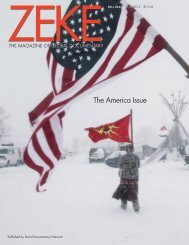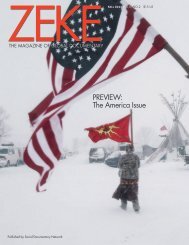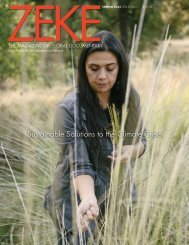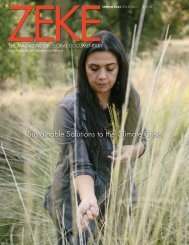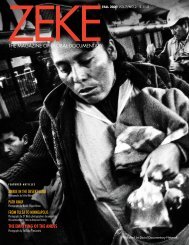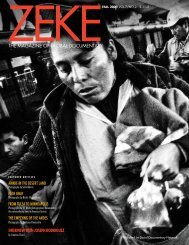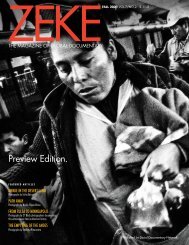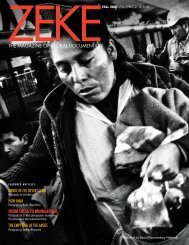Preview Edition: Fall 2023 issue of ZEKE Magazine
The Incarceration Issue. Guest-edited by Christopher Blackwell. Featuring seven photo essays on incarceration in the U.S. Other content includes "Incarceration of a Nation" by Christopher Blackwell, interview with Jamel Shabazz, book reviews, and more.
The Incarceration Issue. Guest-edited by Christopher Blackwell. Featuring seven photo essays on incarceration in the U.S. Other content includes "Incarceration of a Nation" by Christopher Blackwell, interview with Jamel Shabazz, book reviews, and more.
You also want an ePaper? Increase the reach of your titles
YUMPU automatically turns print PDFs into web optimized ePapers that Google loves.
ZEKE
THE MAGAZINE OF GLOBAL DOCUMENTARY PHOTOGRAPHY
Published by Social Documentary Network
FALL 2023 VOL.9/NO.2 $15 US
ABBREVIATED PREVIEW EDITION
The Incarceration Issue
FALL 2023 VOL.9/ NO.2
$15 US
The Incarceration Issue
Photo by Brian Frank from What My Daughter
Learns of the Sea
Photo by Sara Bennett from Life After Life in
Prison
Photo by Peter Merts from Quests for Authenticity
Photo by Michele Zousmer from Absence of
Being
2 | WHAT MY DAUGHTER LEARNS OF THE SEA
Women in Las Calinas Detention and Reentry Facility
By Brian Frank
10 | LIFE AFTER LIFE IN PRISON
The Bedroom Project
By Sara Bennett
18 | QUESTS FOR AUTHENTICITY
Artists in California Prisons
By Peter Merts
38 | THE PRISON WITHIN
By Katherin Hervey and Massimo Bardetti
30 | STILL DOING LIFE
25 Years Later
By Howard Zehr
42 | ABSENCE OF BEING
By Michele Zousmer
52 | FINAL EXPOSURE
Portraits From Death Row
By Lou Jones
26 | Incarceration of a Nation
By Christopher Blackwell
58 | Open Eyes Within Hidden Places
By April Harris
62 | Interview With Jamel Shabazz
By Ryan M. Moser
66 | Book Reviews
On the Cover:
Photograph by
Michele Zousmer
Las Colinas Rehabilitation
and Detention and
Reentry Facility for women
Photo by Lou Jones from Final Exposure
ZEKE
THE
Subscribe to ZEKE today and
receive print edition. Learn more » »
MAGAZINE OF
GLOBAL DOCUMENTARY
PHOTOGRAPHY
Published by Social Documentary Network
Dear ZEKE Readers:
I am so excited to have been offered the role of guest editor for this
special edition of ZEKE magazine dedicated to one of the biggest issues
we face as a country — mass incarceration. Many of you may not think
often of the carceral system, believing it has minimal impact upon your
life. But in reality a third of all Americans are in some way connected to
the carceral system.
We’ve been led to believe that we need prisons and jails to keep us
safe. That without them our communities will suffer. But our communities
are suffering because of them — especially impoverished communities,
mostly filled with Black and Brown people. These communities have been
stripped of countless members to feed the machine of the prison industrial
complex. A system that harvests our children as they are locked up at
ages as early as 10 years old!
For prisons and jails to truly keep us safe, the individuals that enter the
system would need to be receiving proper support and treatment for what
led them to prison in the first place. That way when people are released,
they can be contributing members of society. Yet, rehabilitation has long
been an afterthought inside majority of the prisons across America.
Today, many prisoners are simply being warehoused and abused
through disciplinary measures such as solitary confinement and then
dumped back into our communities with little or no resources. Leading
them right back to the only thing they know —- a life of crime and
violence so they can survive.
We must demand more. We can reconstruct the system to reshape
people. We can offer people a hand to rebuild their lives and a way
to process their traumas and hardships rather than punishment and
ostracizing them from being a member of our communities.
Often the people who fill our jails and prisons are only there because
of the traumatic experiences they’ve been forced to endure throughout
their whole lives, or the lack of investment and opportunity offered to
them. We must fix that by building the commUNITY we want to live in,
one that’s constructed from love and unity; not hate, abuse, and division.
This issue of ZEKE will offer you a view into the lives of those impacted
by the carceral system. Through testimony and imagery, you’ll be given
a deep look into the lives of those most impacted. The photos will display
the rawness of those suffering and will hopefully inspire you to fight
against this draconian structure.
We are in this fight together, so let’s educate ourselves to understand
the harms we are causing through the use of jails and prisons, and let’s
demand better!
Christopher Blackwell
Guest Editor
A little over three months ago, while looking
for someone knowledgeable about the criminal
justice system in the U.S. to be guest editor for
this issue, I saw an opinion piece in the New
York Times by Christopher Blackwell titled, “Two
Decades of Prison Did Not Prepare Me for the
Horrors of County Jail.” His bio said that he is
an incarcerated writer and a co-founder of the
nonprofit Look2Justice. I immediately shot off
an email to Look2Justice to see if they could
recommend someone. To my surprise, two
days later I received an email from Chris from
prison saying he was interested. Thus began an
enduring working relationship, friendship, and
education on the topic of this issue of ZEKE.
More than 100 emails and a dozen phone
calls later (Zoom is not an option), I am so thrilled
to present this special issue of ZEKE Magazine. I
am truly indebted to Chris and the many writers
and prisoner advocates whom he introduced me
to. In addition to Chris’s essay “Incarceration of
a Nation,” do not miss the extraordinary piece
by April Harris “Open Eyes Within Hidden
Places” about her own indignities experienced
while currently incarcerated. In addition there are
seven deeply moving photo essays, an interview
with Jamel Shabazz, and book reviews. I also
want to thank three people whose names do not
appear anywhere else since they are not writers,
photographers, or editors but were invaluable
in facilitating communications with incarcerated
writers—April Nonko, Robert Jensen, and
Jessica Schulberg.
Before closing, I want to inform our readers
of the redesigned ZEKE website (www.
zekemagazine.com). We are finally recognizing
that we have very important content to share and
we want to make it more accessible by creating
a full web version of what you see in the print
magazine.
Glenn Ruga
Executive Editor
ZEKE FALL 2023/ 1
What My Daughter
Learns of the Sea
Women in Las Calinas Detention and Reentry Facility
by Brian Frank
What My Daughter Learns of The
Sea is a look behind the walls of
the Las Colinas women’s jail in
San Diego, CA.
Las Colinas’ approach to
gender-specific incarceration is
considered revolutionary, with its expansion
of an honors program that allows women
more freedoms inside its walls and access to
a wide range of job training, in addition to
physical and mental health programming.
Trauma is the common denominator
underlying the life experience of the vast
majority of female inmates. More than half
of female prisoners are survivors of physical
or sexual violence with 73% of female
state inmates and 61% of female federal
inmates suffering mental health problems.
Much of the honor programs at Las Calinas
attempts to address these issues.
However, in the criminal justice system
in general, women are often ranked at a
higher security level than necessary due to
a classification system based on their male
counterparts. Although Las Colinas is on
the forefront of a gender-specific progressive
response towards women’s incarceration,
these dated classification systems, as
well as staffing and budget constraints,
keep most women at the jail under a more
traditional type of lockdown, something
that many at the prison, both inmates and
staff, would like to change.
2 / ZEKE FALL 2023
Pamela Hernandez and
Kathleen Salinas sit together in
the exercise yard of their highlevel
cell block at Las Colinas
correctional facility in San
Diego, CA.
ZEKE FALL 2023/ 3
Women at the Las
Colinas correctional
facility take a break from
sewing prison uniforms to
watch Downton Abbey.
4 / ZEKE FALL 2023
Subscribe to ZEKE today and
receive print edition. Learn more » »
ZEKE FALL 2023/ 5
Women at the Las Colinas correctional
facility sing together while
folding the prison’s laundry. Having
a laundry room job is considered a
privilege, reserved for detainees who
have demonstrated good behavior.
6 / ZEKE FALL 2023
ZEKE FALL 2023/ 7
8 / ZEKE FALL 2023
LIFE AFTER LIFE
IN PRISON
The Bedroom Project
by Sara Bennett
F
or nine years, Sara Bennett
photographed formerly
incarcerated women in their
bedrooms. All were convicted of
serious crimes — mostly homicide
— and spent 14 to 37 years in
a maximum-security prison. By the time
they came up for parole they were all
profoundly changed, yet most of them
were repeatedly denied release because
of the crimes they had committed
decades earlier
“These women were open and trusting
enough to allow me into their most
private spaces — their bedrooms — and
to share the handwritten comments that
accompany the photos. Like me, they
hope this work will shed light on the
pointlessness of extremely long sentences
and arbitrary parole denials, and thus
help their friends still in prison: women
(and men) like them who deserve a
chance at freedom.”
Karen: 69, in a homeless shelter four weeks
after her release. East Village, NY (2017)
Sentence: 25 years to life
Served: 35 years
Released: April 2017
“When I made parole plans, I thought I was
going to have a good re-entry situation in
the house I paroled to. I realized almost
immediately that it wouldn’t work out, so I
left, without anywhere else to go.
“Parole sent me to a homeless assessment
shelter in the south Bronx. The quality of the
bedding and the food was a lateral move
from prison . But factoring in my freedom,
there’s no question that it was an improvement.
“Now, I’m in a shelter run by the
Women’s Prison Association. I feel safe and
secure. The room is spare, with not much in
it, but it’s mine.
“In this room, I find comfort, privacy,
safety, and peace of mind.”
ZEKE Fall 2023/ 9
10 / ZEKE FALL 2023
Subscribe to ZEKE today and
receive print edition. Learn more » »
Tracy: 51, in her own apartment
three-and a half years
after her release. Jamaica, NY
(2017)
Sentence: 22 years to life
Served: 24 years
Released: February 2014
“I imagined coming home,
living in a one- or two-bedroom
apartment, where one was a
master and an extra room for
guests. Here I have that. I call
this room my ‘doll house,’ my
safe haven. I feel at peace.
I’ve finally unpacked. I spend a
lot of time in here. I take pride
in everything. I put more into
this room than into the kitchen.
I know I need to eat, but my
room is my nutrition.”
ZEKE FALL 2023/ 11
By Christopher Blackwell
Blackwell
The United States has the highest
rate of incarceration in the world,
imprisoning 664 per 100,000
people. On any given day in the
U.S., we imprison an estimated 1.9
million people and each year spend
an estimated $182 billion on the
criminal legal system.
Christopher Blackwell is an
award-winning journalist currently
incarcerated at the Washington
Corrections Center, Shelton, WA. He
is serving a 45-year prison sentence
for taking another human’s life
during a drug robbery—something
he takes full accountability for.
He was raised in a mixed Native
American/white family in the Hilltop
Area of Tacoma, Washington, one
of the roughest places to live in the
country– ravaged by over-policing,
gangs, violence, and drugs.
I
was 12 years old the first
time I was incarcerated. This
wasn’t uncommon where I
grew up, in the impoverished
and overpoliced Hilltop area
of Tacoma, Washington. One
day in 1993, a cop frisked
my friend and I while we
were on our way home from
school. I had a small amount
of marijuana in my sock — but enough
to change my life forever. The cop
found the weed in my backpack and
my school books were replaced with
handcuffs. I was hauled off to juvenile
detention, the beginning of my long
journey through the carceral system.
Thirty years later, I’ve still been unable
to free myself from its grasp.
This is the system we have created
in America, one that targets the poor to
feed the monster of mass incarceration.
It is a system sustained by fear and
misconceptions that crime is, somehow,
always on the rise and that we
must take action to keep our communities
safe. This narrative is reinforced
daily, from TV shows like Law and
Order to breathless news coverage of
crime, which often lacks context about
broader trends or the specific circumstances
that led to a particular crime.
The only solution, we are told, is to
incarcerate more and more people for
longer and longer periods of time.
In reality, the “overall crime rates
remain near historic lows,” the Prison
Policy Initiative wrote in a recent report.
Even during a spike in homicides in
2020, which is now declining, homicide
rates remained far below their
peak in the 1980s and 1990s. “What
has actually changed the most is the
public’s perception of crime,which is
driven less by first-hand experience
than by the false claims of reform
opponents,” the report continued, citing
public polling data.
Politicians responded by using the
violent crime spike in the 1980s and
90s to justify a tough-on-crime crackdown.
They spread the racist myth that
the country would be overwhelmed by
a wave of “super-predator” youth —
mostly used to refer to Black and Brown
boys — who would kill for no reason
at all. In this climate of fear, voters
and lawmakers throughout the country
12 / ZEKE Fall 2023
Subscribe to ZEKE today and
receive print edition. Learn more » »
dramatically increased prison sentences
and worked to oust from office those
who didn’t fall in line.
In my home state of Washington,
voters passed Initiative 593, commonly
referred to as “Three Strikes,” mandating
life without parole sentences for
people convicted three times of certain
crimes. Until recent legislative reform,
hundreds of people were struck out,
serving life without parole sentences for
second degree robbery offenses, which
can include stealing food from a grocery
store. For some, their “strikes” date back
to cases from when they were kids,
waived into adult court. Some even had
crimes committed under the age of 18
used against them to get stuck out, often
because they refused a plea deal for
decades in prison by prosecutors.
Disproportionate Harm
Just two years after three strikes,
Washington imposed weapons
enhancements under a bill called the
Hard Time for Armed Crime Act of
1995, resulting in longer prison sentences.
Despite the promise that these
harsh laws would reduce crime, there
is no evidence that occurred. Rather,
crime rates were already declining
nationwide, both in states with similar
laws and those without. Meanwhile,
prison populations exploded. In
Washington, the state’s prison population
nearly tripled from about 9,800
people in state prisons and jails in
1983 to 26,913 by 2015, according
to the Vera Institute. The expansion of
life without parole sentences has created
a ballooning aging population,
at great cost to the state. In 2001, the
Sentencing Commission found that
elderly prisoners cost more than four
times as much to imprison as the average
prisoner — a finding the commission
found “even more troubling” given
how rarely the elderly recidivate.
Today, the United States has the
highest rate of incarceration in the
world, imprisoning 664 per 100,000
On the yard. San Quentin Prison. Photograph by Katherin Hervey from The Prison Within.
people. For reference, Canada imprisons
just 104 per 100,000 people. On
any given day in the U.S., we imprison
an estimated 1.9 million people (1.26
million in state and federal prisons
and about 514,000 in local jails). The
U.S. spends an estimated $182 billion
on the criminal legal system per year,
including $81 billion for prisons, jails,
probation and parole.
Over the past 50 years, the state
and federal prison population has
grown by a staggering 700%. It is
clear that impoverished communities of
color are disproportionately harmed by
increased incarceration. Although Black
people make up 38% of the prison
and jail population, they represent only
12% of the U.S. population.
“Incarceration is a traumatizing
experience both for those who are
locked up and for those who love
them,” Melissa R Lee, the assistant
director of the Fred T. Korematsu Center
for Law and Equality wrote in an email.
It “deprives loved ones of their children,
their parents, their partners, their
friends, and of the experience of living
together. It also deprives communities,
especially communities of color, and
society at large, of vast amounts of talent
and resources.”
Having spent most of my life in the
criminal legal system, I have witnessed
one heartbreaking story after another.
Like Jonathan (Jon) Kirkpatrick, now
serving a life sentence for a murder he
committed at the age of 19.
Jon grew up in extreme poverty.
His mother, who had been married six
times during his childhood, struggled to
support her children. Some of the men
she brought home were abusive. One
of his stepdads was an escaped convict
who took him and his family on the run,
evading the U.S. Marshals for years.
They lived in rundown motels, where
drug addiction, violence and sex work
were common.
Looking to escape this toxic environment,
Jon moved in with his biological
father. He quickly realized that this living
situation was no better. His father beat
him often and by the age of 11, Jon
was using meth. He spent much of his
childhood in juvenile group homes and
eventually dropped out of school. Living
on the streets of Los Angeles, he did sex
work to pay for his drug addiction. He
was a kid trying to survive in environments
that would jade him forever.
Jon leaned further into drug use, the
only thing that helped him forget the
cards he’d been dealt. As he struggled
to afford his habit, he fell into a dangerous
path of robbing drug dealers and
stealing anything of value. Tragically,
someone lost their life and Jon lost his
freedom.
Now three decades later, Jon is
drug-free, a mentor to younger prisoners,
and a successfully published writer.
These changes were possible because
people began to see who Jon really
was and invest in him. Older prisoners
in mentorship roles taught him how to
facilitate non-violent communication
dialogues. He connected with others
who struggled with addiction through
Narcotics Anonymous and learned
to lead those meetings. Eventually, he
partnered with the nonprofit group
ZEKE FALL 2023/ 13
San Quentin Prison. Photograph by Katherin Hervey from The Prison Within.
Empowerment Avenue, which supported
him in publishing his writing in mainstream
media outlets. (Empowerment
Avenue also supports my writing.) One
step at a time, Jon developed his confidence
and grew into the man he was
always meant to be.
It has become exceedingly apparent
that the majority of people in prison
are here due to the circumstances they
grew up in, which were often out of
their control. They are the victims of
being born into poverty, abusive or
neglectful families, over-policed neighborhoods,
and the violence that these
conditions create. In short, they have
spent their entire lives living to survive,
not to thrive. They carry generational
trauma and often lifelong connections
to the carceral system.
“Prison exacerbates all of those
feelings,” James King, the co-director
of programs at the Ella Baker Center
for Human Rights, said in an interview.
“If you felt low self-worth in your family,
wait until you see an indictment
that says, ‘The State of California vs.
James King.’ You’ll feel a little bit more
isolated.”
Unjust Financial Burdens
“If you have feelings of low self-worth
or low self-esteem, prison increases
those feelings and significantly contributes
to the lack of tools to deal with
trauma that underlie where a lot of
harmful activities come from in the first
place,” King said.
It’s not just the people imprisoned
who are harmed by the status quo —
our family members and loved ones
bear an enormous emotional, logistical
and financial burden as well. First
there’s the cost of legal support, for
those who can even afford to hire a
lawyer. Families often borrow from
friends, take out loans, or even sell their
homes to hire lawyers they hope can
bring their loved ones home. But the
cost doesn’t stop there. Once inside,
prisoners are faced with a deluge of
fines and fees related to victim’s funds,
court costs and the cost of incarceration.
If my family sends me any money,
roughly 50% of it gets taken out for
these fees. As a result of these high fees
and low wages, many prisoners rack
up institutional debt just by purchasing
things like soap, toothpaste and
stationery to stay in touch with friends
and family.
Everything in jail and prison — from
phone calls to Top Ramen to a sheet of
paper — costs exponentially more than
in the free world. And because prisoners
typically earn pennies per hour for
their labor, the costs of basic necessities
fall to our loved ones. Private companies
that provide commissary goods
or phone services to prisons bring in
$2.9 billion per year, the Prison Policy
Initiative estimated in 2019. Inflation
in recent years has only driven up the
prices of food and personal hygiene
products. Maintaining relationships is
expensive too. Visiting requires taking
time off work and often spending
hundreds, if not thousands of dollars in
travel and accommodation.
“I hate that they need to support me
in this way,” Bud Fraser, who is incarcerated
in Washington state, said in an
interview. “Knowing they struggle to do
it is frustrating.”
Inside of each and every prison in the
U.S., you will find a humanitarian crisis.
The infrastructure is rotting, the pipes
are eroding, the water is often contaminated,
the heat and the air conditioning
are constantly broken (or non-existent),
flooding is common, mold spreads
freely, and infectious diseases run rampant.
We subsist on a diet of processed
foods — even the prisoners put to work
growing crops often do not have access
to the fresh fruits or vegetables they
grow. Violence is commonplace, both
from guards who operate with impunity,
and from other prisoners, many of
whom are in desperate need of mental
healthcare. We have minimal access to
medical care and plenty of reasons not
to trust the medical professionals inside.
(In my state of Washington, the prison
ombudsman found that medical staff in
facilities throughout the state delayed
for months in diagnosing and treating
cancer patients, sometimes resulting in
death.)
Many facilities operate beyond their
intended maximum capacity, the risk
of which was made especially clear
as COVID-19 tore through prisons and
jails. It is no coincidence that incarcerated
people have accounted for a
disproportionate amount of the pandemic’s
death toll.
Forced to live in these unsafe
environments, we are often sentenced
to more than simply a loss of liberties
and freedom. Spending time in prison
can be a death sentence, even if that
wasn’t the assigned punishment. Each
year that someone spends in prison
decreases their life expectancy by two
years, the Vera Institute found.
Although prisons pay lip service to
rehabilitation, carceral environments
encourage violence and often punish
efforts at self-betterment. The few
rehabilitative programs that do exist
are often watered-down classes that
exist to justify more funding for the
prisons. Prisons function primarily to
14 / ZEKE FALL 2023
warehouse people until their time is
up, at which point they are released
back into the community with limited
resources, extensive unprocessed
trauma, and a criminal record that
restricts their employment and housing
opportunities.
Alternatives to Incarceration
True change doesn’t come from spending
an arbitrary number of years locked
up — it comes from accountability and
learning to love and respect yourself.
Those of us who learn to take responsibility
for the harm that we have caused
and have the sense of self-worth to hold
ourselves to a higher standard have
done so in spite of, not because of, the
prison system.
It doesn’t have to be this way. We
do not need prisons to keep us safe —
and there’s plenty of evidence that they
only put us in more danger. Although
prison abolition sounds like a far-off
reality, we already have a model of an
alternative way of addressing harm.
“When I think about the principles
of abolition, I think about many of the
wealthiest and most resourced communities
among us, and look at them
as a template in the roadmap for what,
in an ideal world, would be available
for everyone,” said King. “They have
the resources needed in those communities
to address trauma, for people to
have a living wage, for people to have
affordable housing, for people to live in
healthy environments. Their basic needs
are taken care of so they are able to
work towards better communities.”
“Equally important to that is, as
they’re growing up and they are
sometimes creating harm in their
neighborhood, it’s not criminalized, it’s
treated as something that needs to be
addressed through means other than
the criminal system,” King continued.
Seeking alternatives to incarceration
does not mean abandoning accountability.
As a society, we will always need
ways to address harm that is caused, but
the U.S. criminal legal system and incarceration
rarely do a good job of making
anyone feel whole,” Lee said. “Locking
people up doesn’t result in healing for
either the person who was harmed or
for the responsible party. Creating more
possibilities to address the harm itself
will result in much better outcomes for
everyone involved.”
Resources
Prison Policy Initiative
www.prisonpolicy.org
Prison Policy Initiative produces national
and state level research and data about
incarceration in prisons, jails and other
detention facilities.
Sentencing Project
www.sentencingproject.org
The Sentencing Project works to minimize
imprisonment and criminalization by
promoting racial, ethnic, economic and
gender justice.
Worth Rises
www.worthrises.org
Worth Rises works to dismantle the prison
industry, expose the commercialization of
the criminal legal system, and organize
to protect the economic resources of
impacted communities.
FAMM
www.famm.org
Families Against Mandatory Minimums
was founded in 1991 to challenge mandatory
minimum sentences. It continues to
work to create a more fair and effective
justice system.
Innocence Project
www.innocenceproject.org
The Innocence Project works to free the
innocent, prevent wrongful convictions
and create fair, compassionate and equitable
systems of justice.
Black and Pink
www.blackandpink.org
Black and Pink is a prison abolitionist
organization that supports LGBTQ and HIVpositive
people who are incarcerated.
Dream.org
https://dream.org
Dream.org focuses on ending mass incarceration,
stopping climate change, and
alleviating economic inequality.
ACLU-National
www.aclu.org
The American Civil Liberties Union works
through litigation and lobbying to defend
and preserve individual’s guaranteed
constitutional and legal rights.
Unlock the Box:
www.unlocktheboxcampaign.org/Unlock
An advocacy campaign aimed at ending
solitary confinement, a UN-recognized
form of torture, in U.S. prisons, jails,
detention, facilities and juvenile facilities.
Empowerment Avenue
www.empowermentave.com
Empowerment Avenue works to normalize
the inclusion of incarcerated writers
and artists in mainstream publications
and venues. It supports writers and artists
in prisons and helps them place and get
compensated for their work.
National Disability Rights
Network:
www.ndrn.org
The National Disability Rights Network is
the only legally based advocacy organization
established by Congress to protect
the rights of people with disabilities,
including those who are incarcerated.
Look2Justice
https://look2justice.org
Look2Justice is a grassroots organization
of system-impacted organizers and
researchers who use an inside-out organizing
model to cultivate justice, fairness
and accountability in Washington state’s
ZEKE FALL 2023/ 15
16 / ZEKE FALL 2023
Absence of Being
by Michele Zousmer
In August 2014, San Diego Sheriff
Bill Gore spoke to me about a new
reentry program starting at Las
Colinas Detention and Reentry Center
for women. He asked me if I could
‘change the perception of the female
convict with my images.’ The following
week I entered Las Colinas open to this
new challenge.
Listening to the women I quickly realized
they were all victims of physical,
emotional, and/or sexual abuse. They
all experienced hardships and suffered
deprivation. As an observer, I heard their
tales and felt their pain. My heart hurt for
them.
As my involvement deepened, my
relationships with these women grew.
I shared the grief I was feeling being
recently widowed. They appreciated
my expressing vulnerability. I encouraged
them to discard their shame and
not allow incarceration to define them. I
showed up for them.
Reentry is a big challenge in the judicial
system. Women’s issues are different.
Many women are single parents who
will be reunited with their children. Their
criminal behavior was associated with
negative self-esteem from their complicated
histories. I gave them hope. I made
them smile.
ZEKE FALL 2023/ 17
18 / ZEKE FALL 2023
Subscribe to ZEKE today and
receive print edition. Learn more » »
ZEKE FALL 2023/ 19
final
exposure
by Lou Jones
Portraits from Death Row
The Final Exposure project started for me
at about age 15 when I argued on the
issues of the death penalty with my father.
Throughout the Civil Rights movement, the
Vietnam War, in college, and afterward,
it stayed with me. Six years of my life
have been devoted to documenting the unseen,
unheard stories of an American subculture –
people on death row. I wanted to see if art could
make a difference. I realized before I began that
we don’t have to travel halfway around the world
to find some unique phenomenon or recently discovered
civilization to pique our jaded curiosity.
The problem of our government-sanctioned murder
lives with us.
My crew and I endured bone-chilling snowstorms,
cheap motels, greasy meals, and numerous
episodes of having our bodies frisked in
order to bring this story to light. We explored the
darkest side of the human condition even though
it was our objective to humanize the people that
the federal government and the states execute.
We made sure we understood who was being
killed in order to start a real debate about capital
punishment. Many of the men/women are stoic
when marching to their demise. But even though
we admire the stamina that it takes to endure this
ordeal in the super-macho environment, these are
not heroic voyages these men are taking. And we
must never be seduced into thinking otherwise.
Edward Dean “Sonny”
Kennedy
Florida State Prison
Starke, Florida
Year of birth: 1945
Marital status: Single
Children: None
Date of offense: April 11, 1981
Sentenced to death: January 12,
1982
Status: Executed July 21, 1992 by
electrocution
20 / ZEKE FALL 2023
ZEKE FALL 2023/ 21
LaFonda Fay Foster
Fayette County Detention Center
Lexington, Kentucky
Year of birth: 1963
Marital status: Divorced prior to crime
Children: None
Date of offense: April 23, 1986
Sentenced to death: April 24, 1987
Status: Re-sentenced to life without parole,
January 1999
22 / ZEKE FALL 2023
Subscribe to ZEKE today and
receive print edition. Learn more » »
Nicholas Yarris
State Correctional Institution at Greene
Waynesburg, Pennsylvania
Year of birth: 1961
Marital Status: Married while on death row
Children: None
Date of offense: December 15, 1981
Sentenced to death: January 23, 1983
Status overturned: Exonerated January 2004
ZEKE FALL 2023/ 23
BOOK
REVIEWS
DEATH IN CUSTODY; HOW
AMERICA IGNORES THE
TRUTH AND WHAT WE
CAN DO ABOUT IT
Dr. Mitchell and Dr. Jay Aronson
Johns Hopkins University Press, 2023
312 pages / $28.95
It’s a simple question, one that should
be easy to answer: How many
people in the United States have
been killed by police or died while in
the custody of the criminal system?
The frustrating answer is that no
one knows, because law enforcement
agencies and their allies don’t want
us to know, according to the authors
of Death in Custody: How America
Ignores the Truth and What We Can
Do about It.
Roger A. Mitchell Jr. and Jay D.
Aronson provide details and data
about the alarming number of people
who have been killed during encounters
with law enforcement.
First, the details. While some were
gunned down and brutally beaten by
police officers, others “mysteriously” died
while confined in the horrible conditions
all too common in jails and prisons
across the country. Yet it is rare for law
enforcement agencies to be held accountable
for these preventable deaths.
One of the many examples the
authors present is from an investigation
by Mike Masterson, a young
journalist who has dedicated his
career to reporting what happens in
police precincts, mental health care
facilities, courtrooms, jails, prisons,
and medical examiners’ offices.
Masterson found that in Chicago’s
Harrison District police lockup, more
than 20 men were declared to have
died by suicide in police custody
over 20 months. The majority were
Black or Latinx, and seven of them
had been arrested for minor crimes.
According to the medical examiners,
10 had hung themselves with belts
and shoelaces, and most of them had
been locked up for only a few hours
before they died. Despite clear signs
of brutal treatment, no one was held
accountable, mainly because of the
medical examiners’ findings.
Second, where is the data?
Mitchell and Aronson point out that
one of the primary reasons for the
lack of accountability is the absence
of reliable information about those
who have died during encounters
with law enforcement. In addition,
they provide compelling evidence
that racist and biased ideologies
have motivated medical examiners
to either exclude or falsify autopsies
when a death incriminates the legal
system or political allies.
As it has become clear that these
injustices are not anomalies, activists
and journalists have pressed the criminal
justice system for greater transparency
and accountability, only to be met
with excuses for why it can’t be done.
But the authors point out that the U.S.
government has been able to track
every other type of death. The refusal
to account for those who have died in
prisons and jails, and at the hands of
police, speaks to the miniscule value
that law-enforcement agencies have
placed on communities of color who
are disproportionately being killed.
In response to this very real problem,
Mitchell and Aronson call for the
National Center for Health Statistics to
add a check-box to death certificates
for those who have died during interactions
with the criminal legal system.
They argue that in a democracy, citizens
should be able to figure out how
many people are killed during interactions
with law enforcement, why they
are killed, and whether training and
policies can be modified to decrease
the number of officer-involved deaths.
Without this data, citizens won’t be
able to analyze trends and demand
action. The result: no accountability.
Nearly all homicides committed by
police are written off as “justified,”
and people will continue to lose their
lives, all under the narrative of protecting
society from crime.
The refusal to account for those who
have died in prisons and jails, and at the
hands of police, speaks to the miniscule
value that law-enforcement agencies
have placed on communities of color who
are disproportionately being killed.
This problem is hardly new. Death
in Custody provides readers with the
brutal history on which the U.S. criminal
legal system was built. Beginning
with the gruesome era following
the enslavement of Black people in
America, the book unpacks the history
of how Blacks were lynched by White
supremacists and then dehumanized
by racist narratives as a means
of justifying these barbaric acts of
murder. When Ida B. Wells and other
anti-lynching activists began to force
greater awareness of these atrocities,
the United States passed an anti-lynching
law. But the country also held onto
White supremacy, shifting from lynching
Blacks to a more professionalized
way of controlling and oppressing
communities of color — the criminal
legal system.
These days, when police shoot an
unarmed person on the streets, there
24 / ZEKE FALL 2023
Subscribe to ZEKE today and
receive print edition. Learn more » »
likely will be media coverage. On
the other end of the spectrum lies the
silent indifference to the wellbeing
of people who are placed in their
custody, especially people of color. As
someone incarcerated in that system,
I have witnessed firsthand this routine
neglect. One example is how an
incarcerated student who had been a
part of a Black Prisoners Caucus educational
programs in Washington state
was inappropriately taken to solitary
confinement. According to prison staff,
the prisoner didn’t feel safe with other
prisoners in the main part of the facility.
Later, that prisoner committed suicide
by slitting his wrist with a razor.
On the surface, one may believe
the prison can bear no fault for the
prisoner’s suicide, but as Mitchell
and Aronson argue, negligence that
leads to death is inexcusable. Solitary
confinement is a place of punishment
and has never been a safe place for
prisoners. In addition, prisoners are
supposed to be thoroughly searched
before being placed in solitary confinement.
Despite this negligence, no
one was held accountable.
Death in Custody shows that from
the late 1800s until today, people
have died under the care of this
same criminal legal system. This book
reveals more than the obvious killings
that happen at the hands of violent
law enforcement officers -— it uncovers
the silent deaths that result from
neglectful prison staff who fail to do
their jobs. The point here is clear:
these unnecessary deaths will continue
to occur until there is a uniform way of
making our judicial system transparent
and accountable for what they do and
don’t do, for those in its care.
—Antoine Davis
Let the World See Your
Documentary Projects
Start uploading your projects
to the SDN website today
• Gain exposure for you and the issues you
are documenting
• Absolutely free for the first year.
www.socialdocumentary.net
OPEN CALL
The En Foco Photography Fellowship is
designed to support New York-based
photographers of color who demonstrate the
highest quality of work as determined by a
photography panel of peers and industry
professionals. The program awards 10
fellowships at $1,000 each, includes fellows in a
group exhibition, features them in the Nueva
Luz publication (printed and online editions),
and provides professional development and
networking opportunities.
MEDIA ARTS FUND: WORK
IN PROGRESS INITIATIVE
En Foco’s Media Arts Fund: Work in Progress
(WIP) Initiative is a grant to support New York
City-based, early-career artists of color who
engage with digital media technologies in their
art-making processes. In collaboration with
BronxNet, these $2,000 awards will focus on
applicants needing support for the completion
of a quality work in progress.
PHOTOGRAPHY
FELLOWSHIP
Visit www.enfoco.org
for upcoming deadlines
ZEKE FALL 2023/ 25
Contributors
Barbara Ayotte is the editor of ZEKE
magazine and the Communications Director
of the Social Documentary Network. She
has served as a senior strategic communications
strategist, writer and activist for leading
global health, human rights and media
nonprofit organizations, including the Nobel
Peace Prize- winning Physicians for Human
Rights and International Campaign to Ban
Landmines.
After 18 years as a public defender,
Sara Bennett turned her attention
to photographing women with life
sentences, inside and outside prison. Her
work has been widely exhibited in solo
shows including at the Blue Sky Gallery
in Portland, OR, and in group shows,
including the Blanton Museum of Art’s Day
Jobs, and featured in publications such as
The New York Times, Variety and Rolling
Stone’s “American (In)Justice”, and others.
Christopher Blackwell is an awardwinning
journalist currently incarcerated
at the Washington Corrections Center,
Shelton, WA. He is serving a 45-year
prison sentence for taking another human’s
life during a drug robbery—something
he takes full accountability for. He was
raised in a mixed Native American/white
family in the Hilltop Area of Tacoma,
Washington, one of the roughest places
to live in the country– ravaged by overpolicing,
gangs, violence, and drugs.
Daniela Cohen is a freelance journalist
and non-fiction writer of South African
origin based in Vancouver, Canada.
Her work has been published in New
Canadian Media, Canadian Immigrant,
eJewish Philanthropy, The Source
Newspaper, and Living Hyphen. Daniela’s
work focuses on themes of displacement
and belonging, justice, equity, diversity
and inclusion. She is also the co-founder of
Identity Pages, a youth writing mentorship
program.
Antoine Davis, 34, is a licensed
minister at Freedom Church of Seattle
currently incarcerated at Washington
Correction Center, serving a 63-year
sentence. His writing has been published
in Counterpunch, The Appeal, Your Teen
Magazine, and many other outlets. Follow
Antoine on Twitter at @AntoineEDavis.
Marissa Fiorucci is a freelance photographer
in Boston, MA. She is former studio
manager for photographer Mark Ostow
and worked on projects including portraits
of the Obama Cabinet for Politico. She
specializes in corporate portraits and
events, but remains passionate about
documentary.
A San Francisco native, Brian Frank
has created social documentary projects
across the Americas focusing on cultural
identity, social inequality, violence,
workers rights and the environment. A
Professor of Journalism and Catchlight
Global-Fellow, Frank has led visual
storytelling workshops for professional
educators and journalists across the USA
and children and teens in the U.S. and
Mexico and lectured on visuals-based
curriculum at universities nationwide. His
work has been recognized with numerous
awards and featured in many publications.
April Harris is an author who is
incarcerated at the California Institution
for Women in Chino, California. Her
experiences are a powerful insight to
advocate for incarcerated people and
the betterment of their environment. She
has been interviewed by LA Weekly,
The Guardian, San Francisco Chronicle,
Washington Post, and Solitary Watch,
among many other outlets.
Katherin Hervey is an artist and awardwinning
filmmaker interested in what is
hiding in the dark crevices of the American
landscape and collective psyches, believing
truth is found in the dark before it shines in
the light. Her first feature film, The Prison
Within, won eight awards. A thought
leader in criminal justice reform, Katherin
has been featured in various media
publications. Her mixed media artworks
and creative fiction have been showcased
in galleries and literary journals.
When not traveling, Lou Jones
exhibits at schools, museums, galleries,
libraries, and institutions around the
world. Throughout his career, Jones has
undertaken personal long-term projects,
such as Japan, tall ships, jazz, pregnancy
and photographing people on fourteen
death rows in the USA, resulting in two
books and many exhibitions. In recent
years, Jones has been documenting all 54
countries in contemporary Africa, trying
to change the narrative from stereotypical
negative topics of poverty, pestilence, and
conflict: www.panAFRICAproject.org.
Peter Merts’s photography spans
documentary, portrait, and fine art forms
and has been published in the New
York Times, the Washington Post, and
others. In 2015, Peter and Dr. Larry
Brewster published Paths of Discovery—
Art Practice and Its Impact in California
State Prisons (second edition.) In Spring
2022, Peter published a monograph of his
photographs as Ex Crucible: The Passion
of Incarcerated Artists. An archive of his
prison arts photographs can be found on
www.petermerts.com.
Ryan M. Moser is a formerly
incarcerated journalist and award-winning
writer from Philadelphia. His work can be
found on muckrack.com/ryan-moser.
Howard Zehr is Distinguished Professor
of Restorative Justice at Eastern Mennonite
University, VA. He is internationally
recognized as one of the founders and
leaders of restorative justice and has been
active as a professional photographer
throughout his career. His publications
include six photo books, including one on
children whose parents are incarcerated,
one highlighting Virginians and their
pickup trucks, and The Little Book of
Contemporary Photography, which
presents a meditative approach.
Michele Zousmer is a humanitarian fine
art photographer who uses her camera
as an instrument to amplify the voices of
marginalized individuals and communities,
conveying curiosity, love, and the enduring
hope within humanity. Through cultivating
genuine connections, the soul of her
images emerges — a poignant reflection
of shared humanity. She aims to offer
solace, empowerment, and a dignified
healing process by exposing the innate
strength and resilience of the human spirit
within each person she captures.
26 / ZEKE FALL 2023
FALL 2023 VOL.9/NO.2
$15 US
ZEKE
THE MAGAZINE OF GLOBAL DOCUMENTARY PHOTOGRAPHY
Published by Social Documentary Network
ZEKE is published by Social Documentary Network (SDN), a
nonprofit organization promoting visual storytelling about global
themes. Started as a website in 2008, today SDN works with thousands
of photographers around the world to tell important stories
through the visual medium of photography. Since 2008, SDN has
featured more than 4,000 exhibits on its website and has had
gallery exhibitions in major cities around the world.
ZEKE
Executive Editor: Glenn Ruga
Editor: Barbara Ayotte
Guest Editor: Christopher Blackwell
SDN and ZEKE magazine
are projects of Reportage
International, Inc., a nonprofit
organization founded in 2020.
Reportage International,
Inc. Board of Directors
Glenn Ruga, President
Eric Luden, Treasurer
Barbara Ayotte, Secretary
Dudley Brooks
Lisa DuBois
John Heffernan
Maggie Soladay
Documentary Advisory Group
To Subscribe:
www.zekemagazine.com
ZEKE does not accept unsolicited
submissions. To be considered for
publication in ZEKE, submit your
work to the SDN website either as
a standard exhibit or a submission
to a Call for Entries.
61 Potter Street
Concord, MA 01742 USA
617-417-5981
info@socialdocumentary.net
www.socialdocumentary.net
www.zekemagazine.com
socdoctweets
socialdocumentarynet
socialdocumentary
Bill Aguado, Bronx, NY
Catherine Edelman, Chicago, IL
Jill Foley, Silver Springs, MD
Lori Grinker, New York, NY
Michael Itkoff, Bronx, NY
Lou Jones, Boston, MA
Ed Kashi, Montclair, NJ
Lekgetho Makola, Johanesburg
Mary Beth Meehan, Providence, RI
Marie Monteleone, New York, NY
Molly Roberts, Washington, DC
Joseph Rodriguez, Brooklyn, NY
Jamel Shabazz, Hempstead, NY
Nichole Sobecki, Kenya
Jamey Stillings, Sante Fe, NM
Steve Walker, Danbury, CT
Frank Ward, Williamsburg, MA
Amy Yenkin, New York, NY
ZEKE is published twice a year by
Social Documentary Network, a
project of Reportage International,
Inc.
Copyright © 2023
Social Documentary Network
ISSN 2381-1390
ZEKE FALL 2023/ 27








